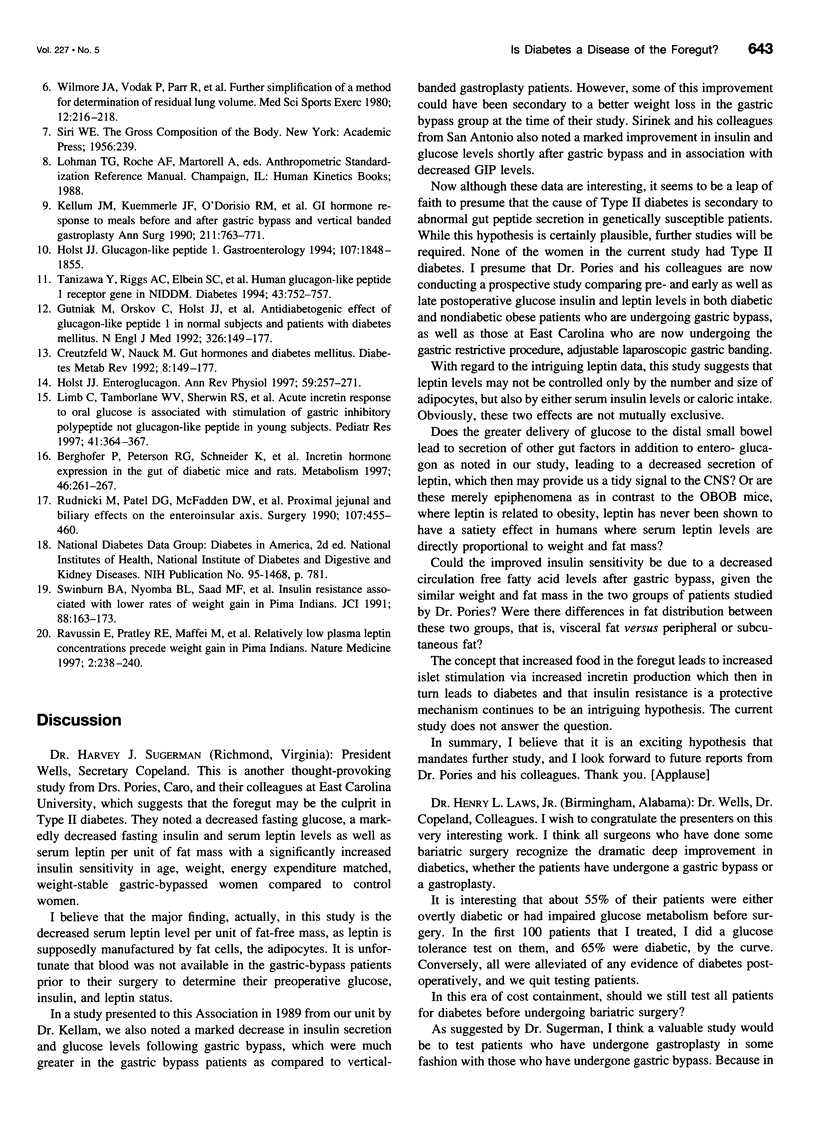Abstract
SUMMARY BACKGROUND DATA: We previously reported, in a study of 608 patients, that the gastric bypass operation (GB) controls type 2 diabetes mellitus in the morbidly obese patient more effectively than any medical therapy. Further, we showed for the first time that it was possible to reduce the mortality from diabetes; GB reduced the chance of dying from 4.5% per year to 1% per year. This control of diabetes has been ascribed to the weight loss induced by the operation. These studies, in weight-stable women, were designed to determine whether weight loss was really the important factor. METHODS: Fasting plasma insulin, fasting plasma glucose, minimal model-derived insulin sensitivity and leptin levels were measured in carefully matched cohorts: six women who had undergone GB and had been stable at their lowered weight 24 to 30 months after surgery versus a control group of six women who did not undergo surgery and were similarly weight-stable. The two groups were matched in age, percentage of fat, body mass index, waist circumference, and aerobic capacity. RESULTS: Even though the two groups of patients were closely matched in weight, age, percentage of fat, and even aerobic capacity, and with both groups maintaining stable weights, the surgical group demonstrated significantly lower levels of serum leptin, fasting plasma insulin, and fasting plasma glucose compared to the control group. Similarly, minimal model-derived insulin sensitivity was significantly higher in the surgical group. Finally, self-reported food intake was significantly lower in the surgical group. CONCLUSIONS: Weight loss is not the reason why GB controls diabetes mellitus. Instead, bypassing the foregut and reducing food intake produce the profound long-term alterations in glucose metabolism and insulin action. These findings suggest that our current paradigms of type 2 diabetes mellitus deserve review. The critical lesion may lie in abnormal signals from the gut.
Full text
PDF






Selected References
These references are in PubMed. This may not be the complete list of references from this article.
- Berghöfer P., Peterson R. G., Schneider K., Fehmann H. C., Göke B. Incretin hormone expression in the gut of diabetic mice and rats. Metabolism. 1997 Mar;46(3):261–267. doi: 10.1016/s0026-0495(97)90251-1. [DOI] [PubMed] [Google Scholar]
- Bergman R. N., Finegood D. T., Ader M. Assessment of insulin sensitivity in vivo. Endocr Rev. 1985 Winter;6(1):45–86. doi: 10.1210/edrv-6-1-45. [DOI] [PubMed] [Google Scholar]
- Creutzfeldt W., Nauck M. Gut hormones and diabetes mellitus. Diabetes Metab Rev. 1992 Jul;8(2):149–177. doi: 10.1002/dmr.5610080206. [DOI] [PubMed] [Google Scholar]
- Holst J. J. Enteroglucagon. Annu Rev Physiol. 1997;59:257–271. doi: 10.1146/annurev.physiol.59.1.257. [DOI] [PubMed] [Google Scholar]
- Holst J. J. Glucagonlike peptide 1: a newly discovered gastrointestinal hormone. Gastroenterology. 1994 Dec;107(6):1848–1855. doi: 10.1016/0016-5085(94)90831-1. [DOI] [PubMed] [Google Scholar]
- Kellum J. M., Kuemmerle J. F., O'Dorisio T. M., Rayford P., Martin D., Engle K., Wolf L., Sugerman H. J. Gastrointestinal hormone responses to meals before and after gastric bypass and vertical banded gastroplasty. Ann Surg. 1990 Jun;211(6):763–771. doi: 10.1097/00000658-199006000-00016. [DOI] [PMC free article] [PubMed] [Google Scholar]
- Limb C., Tamborlane W. V., Sherwin R. S., Pederson R., Caprio S. Acute incretin response to oral glucose is associated with stimulation of gastric inhibitory polypeptide, not glucagon-like peptide in young subjects. Pediatr Res. 1997 Mar;41(3):364–367. doi: 10.1203/00006450-199703000-00010. [DOI] [PubMed] [Google Scholar]
- Long S. D., O'Brien K., MacDonald K. G., Jr, Leggett-Frazier N., Swanson M. S., Pories W. J., Caro J. F. Weight loss in severely obese subjects prevents the progression of impaired glucose tolerance to type II diabetes. A longitudinal interventional study. Diabetes Care. 1994 May;17(5):372–375. doi: 10.2337/diacare.17.5.372. [DOI] [PubMed] [Google Scholar]
- MacDonald K. G., Jr, Long S. D., Swanson M. S., Brown B. M., Morris P., Dohm G. L., Pories W. J. The gastric bypass operation reduces the progression and mortality of non-insulin-dependent diabetes mellitus. J Gastrointest Surg. 1997 May-Jun;1(3):213–220. doi: 10.1016/s1091-255x(97)80112-6. [DOI] [PubMed] [Google Scholar]
- Pories W. J., MacDonald K. G., Jr, Morgan E. J., Sinha M. K., Dohm G. L., Swanson M. S., Barakat H. A., Khazanie P. G., Leggett-Frazier N., Long S. D. Surgical treatment of obesity and its effect on diabetes: 10-y follow-up. Am J Clin Nutr. 1992 Feb;55(2 Suppl):582S–585S. doi: 10.1093/ajcn/55.2.582s. [DOI] [PubMed] [Google Scholar]
- Pories W. J., Swanson M. S., MacDonald K. G., Long S. B., Morris P. G., Brown B. M., Barakat H. A., deRamon R. A., Israel G., Dolezal J. M. Who would have thought it? An operation proves to be the most effective therapy for adult-onset diabetes mellitus. Ann Surg. 1995 Sep;222(3):339–352. doi: 10.1097/00000658-199509000-00011. [DOI] [PMC free article] [PubMed] [Google Scholar]
- Ravussin E., Pratley R. E., Maffei M., Wang H., Friedman J. M., Bennett P. H., Bogardus C. Relatively low plasma leptin concentrations precede weight gain in Pima Indians. Nat Med. 1997 Feb;3(2):238–240. doi: 10.1038/nm0297-238. [DOI] [PubMed] [Google Scholar]
- Rudnicki M., Patel D. G., McFadden D. W., Balasubramaniam A., Nussbaum M. S., Fischer J. E. Proximal jejunal and biliary effects on the enteroinsular axis. Surgery. 1990 Apr;107(4):455–460. [PubMed] [Google Scholar]
- SIRI W. E. The gross composition of the body. Adv Biol Med Phys. 1956;4:239–280. doi: 10.1016/b978-1-4832-3110-5.50011-x. [DOI] [PubMed] [Google Scholar]
- Swinburn B. A., Nyomba B. L., Saad M. F., Zurlo F., Raz I., Knowler W. C., Lillioja S., Bogardus C., Ravussin E. Insulin resistance associated with lower rates of weight gain in Pima Indians. J Clin Invest. 1991 Jul;88(1):168–173. doi: 10.1172/JCI115274. [DOI] [PMC free article] [PubMed] [Google Scholar]
- Tanizawa Y., Riggs A. C., Elbein S. C., Whelan A., Donis-Keller H., Permutt M. A. Human glucagon-like peptide-1 receptor gene in NIDDM. Identification and use of simple sequence repeat polymorphisms in genetic analysis. Diabetes. 1994 Jun;43(6):752–757. doi: 10.2337/diab.43.6.752. [DOI] [PubMed] [Google Scholar]
- Wilmore J. H., Vodak P. A., Parr R. B., Girandola R. N., Billing J. E. Further simplification of a method for determination of residual lung volume. Med Sci Sports Exerc. 1980;12(3):216–218. [PubMed] [Google Scholar]


